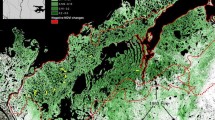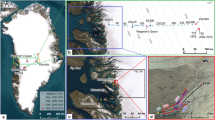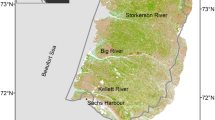Abstract
Local observations, repeat photos, and broad-scale remote sensing suggest that tall shrubs are becoming an increasingly dominant component of Low Arctic ecosystems. This shift has the potential to alter the surface energy balance through changes to the surface albedo, snow accumulation and melt, and ground thermal regimes. However, to date there have been few quantitative estimates of the rate of tall shrub expansion. We used soft copy stereo visualization of air photos to map fine-scale changes in tall shrub tundra and green alder density in the upland tundra north of Inuvik, NT between 1972 and 2004. We also used 2004 photos to map tall shrub tundra in areas affected by fires that occurred between 1960 and 1968. To assess the potential impact of vegetation change on microclimate, we used pyranometers to measure albedo and net solar radiation, thermistors attached to data loggers to record ground temperatures, and field surveys to record winter snow conditions in three common vegetation types. Fine-scale mapping shows that green alder stem density has increased by 68% (±24.1) since 1972. Average tall shrub tundra cover has also increased by 15% (±3.6) since 1972. Historical tundra fires had the highest proportion of tall shrub cover of all areas mapped using 2004 photos, ranging from 92 to 99%. Based on these results, we suggest that predicted increases in the size and frequency of tundra fire are likely to drive rapid shrub proliferation in the Low Arctic. Shrub-dominated sites have decreased albedo, increased net solar radiation, deeper snow pack, and elevated near-surface ground temperatures, indicating that continued increases in shrub cover will affect regional climate, hydrology, permafrost temperatures, and terrain stability.








Similar content being viewed by others
References
Aylsworth JM, Burgess MM, Desrochers DT, Duk-Rodkin A, Robertson T, Traynor JA. 2000. Surficial geology, subsurface materials, and thaw sensitivity of sediments. In: Dyke LD, Brooks GR, Eds. The physical environment of the Mackenzie Valley, Northwest Territories: a base line for the assessment of environmental change. Geological survey of Canada bulletin 547. Ottawa, ON: Geological Survey of Canada. p 41–8.
Beck PSA, Goetz SJ. 2011. Satellite observations of high northern latitude vegetation productivity changes between 1982 and 2008: ecological variability and regional differences. Environ Res Lett 6:045501.
Berezovskaya S, Kane DL. 2007. Measuring snow water equivalent for hydrological applications: part 1, accuracy of observations. In: Proceedings of the 16th International Northern Research Basins Symposium and Workshop. Petrozavodsk, Russia.
Bhatt US, Walker DA, Raynolds MK, Comiso JC, Epstein HE, Jia GS, Gens R, Pinzon JE, Tucker CJ, Tweedie CE, Webber PJ. 2010. Circumpolar Arctic tundra vegetation change is linked to sea ice decline. Earth Interact 14:1–20.
Blok D, Heijmans MMPD, Schaepman-Strub G, Kononov AV, Maximov TC, Berendse F. 2010. Shrub expansion may reduce summer permafrost thaw in Siberian tundra. Glob Change Biol 16:1296–305.
Blok D, Sass-Klaassen U, Schaepman-Strub G, Heijmans MMPD, Sauren P, Berendse F. 2011a. What are the main climate drivers for shrub growth in Northeastern Siberian tundra? Biogeosciences 8:1169–79.
Blok D, Schaepman-Strub G, Bartholomeus H, Heijmans MMPD, Maximov TC, Berendse F. 2011b. The response of Arctic vegetation to the summer climate: relation between shrub cover, NDVI, surface albedo and temperature. Environ Res Lett 6:035502.
Borderlands. 2006. Arctic Borderlands Ecological Knowledge Co-op Community Reports (2005–2006), Annual Report. http://www.taiga.net/coop/community/2005-06/2005-06Community.pdf. Retrieved Nov 10, 2010.
Borderlands. 2007. Arctic Borderlands Ecological Knowledge Co-op Community Reports (2006–2007), Annual Report. http://www.taiga.net/coop/community/2006-07/2006-07community.pdf. Retrieved Nov 10, 2010.
Bret-Harte MS, Shaver GR, Chapin FS. 2002. Primary and secondary stem growth in arctic shrubs: implications for community response to environmental change. J Ecol 90:251–67.
Burn CR, Kokelj SV. 2009. The environment and permafrost of the Mackenzie delta area. Permafr Periglac Process 20:83–105.
Chapin FS, Sturm M, Serreze MC, McFadden JP, Key JR, Lloyd AH, McGuire AD, Rupp TS, Lynch AH, Schimel JP, Beringer J, Chapman WL, Epstein HE, Euskirchen ES, Hinzman LD, Jia G, Ping CL, Tape KD, Thompson CDC, Walker DA, Welker JM. 2005. Role of land-surface changes in Arctic summer warming. Science 310:657–60.
de Groot WJ, Wein R. 2004. Effects of fire severity and season of burn on Betula glandulosa growth dynamics. Int J Wildland Fire 13:287–95.
Duchesne C, Ednie M, Wright JF. 2007. Digital elevation model of the Mackenzie River Valley, Northwest Territories. Geological Survey of Canada, Open File 5337. http://geoscan.ess.nrcan.gc.ca/text/geoscan/metadata/of5337_5-e.htm. Retrieved Nov 12, 2010.
Elmendorf SC, Henry GHR, Hollister RD, Bjork RG, Bjorkman AD, Callaghan TV, Collier LS, Cooper EJ, Cornelissen JHC, Day TA, Fosaa AM, Gould WA, Gretarsdottir J, Harte J, Hermanutz L, Hik DS, Hofgaard A, Jarrad F, Jonsdottir IS, Keuper F, Klanderud K, Klein JA, Koh S, Kudo G, Lang SI, Loewen V, May JL, Mercado J, Michelsen A, Molau U, Myers-Smith IH, Oberbauer SF, Pieper S, Post E, Rixen C, Robinson CH, Schmidt NM, Shaver GR, Stenstrom A, Tolvanen A, Totland O, Troxler T, Wahren CH, Webber PJ, Welker JM, Wookey PA. 2012. Global assessment of experimental climate warming on tundra vegetation: heterogeneity over space and time. Ecol Lett 15:164–75.
Endrizzi S, Marsh P. 2010. Observations and modeling of turbulent fluxes during melt at the shrub-tundra transition zone 1: point scale variations. Hydrol Res 41:471–91.
Epstein HE, Beringer J, Gould WA, Lloyd AH, Thompson CD, Chapin FS, Michaelson GJ, Ping CL, Rupp TS, Walker DA. 2004a. The nature of spatial transitions in the Arctic. J Biogeogr 31:1917–33.
Epstein HE, Calef MP, Walker MD, Chapin FS, Starfield AM. 2004b. Detecting changes in arctic tundra plant communities in response to warming over decadal time scales. Glob Change Biol 10:1325–34.
Forbes BC, Ebersole JJ, Strandberg B. 2001. Anthropogenic disturbance and patch dynamics in circumpolar arctic ecosystems. Conserv Biol 15:954–69.
Forbes BC, Fauria MM, Zetterberg P. 2010. Russian Arctic warming and ‘greening’ are closely tracked by tundra shrub willows. Glob Change Biol 16:1542–54.
Fraser RH, Olthof I, Carriere M, Deschamps A, Pouliot D. 2011. Detecting long-term changes to vegetation in northern Canada using the Landsat satellite image archive. Environ Res Lett 6:045502.
Gilbert H, Payette S. 1982. Écologie des populations d’aulne vert (Alnus crispa (Ait.) Pursh) á la limite des forêts, Québec Nordique. Géographie physique et Quaternaire 36:109–24.
Gillett NP, Weaver AJ, Zwiers FW, Flannigan MD. 2004. Detecting the effect of climate change on Canadian forest fires. Geophys Res Lett 31:L18211. doi:10.1029/2004GL020876.
Higuera PE, Brubaker LB, Anderson PM, Brown TA, Kennedy AT, Hu FS. 2008. Frequent fires in ancient shrub tundra: implications of paleo-records for arctic environmental change. PLoS ONE 3:e0001744.
Holroyd P, Retzer H. 2005. A peak into the future: the potential landscape impacts from gas development in northern Canada. Calgary, AB: The Pembina Institute for Appropriate Development.
Hu FS, Higuera PE, Walsh JE, Chapman WL, Duffy PA, Brubaker LB, Chipman ML. 2010. Tundra burning in Alaska: linkages to climatic change and sea ice retreat. Journal of Geophysical Research-Biogeosciences 115:G04002.
Jia GSJ, Epstein HE, Walker DA. 2003. Greening of arctic Alaska, 1981–2001. Geophys Res Lett 30. doi:10.1029/2003GL018268.
Johnstone JF, Kokelj SV. 2008. Environmental conditions and vegetation recovery at abandoned-drilling mud sumps in the Mackenzie Delta region, NWT, Canada. Arctic 61:199–211.
Jones BM, Kolden CA, Jandt R, Abatzoglou JT, Urban F, Arp CD. 2009. Fire behavior, weather, and burn severity of the 2007 Anaktuvuk River Tundra Fire, North Slope, Alaska. Arct Antarct Alp Res 41:309–16.
Jorgenson MT, Racine CH, Walters JC, Osterkamp TE. 2001. Permafrost degradation and ecological changes associated with a warming climate in central Alaska. Clim Change 48:551–79.
Kemper JT, Macdonald SE. 2009a. Directional change in upland tundra plant communities 20–30 years after seismic exploration in the Canadian low-arctic. J Veg Sci 20:557–67.
Kemper JT, Macdonald SE. 2009b. Effects of contemporary winter seismic exploration on low Arctic plant communities and permafrost. Arct Antarct Alp Res 41:228–37.
Kokelj SV, Burn CR. 2003. Ground ice and soluble cations in near-surface permafrost, Inuvik, Northwest Territories, Canada. Permafrost Periglac 14:275–89.
Kokelj SV, Lantz TC, Kanigan J, Smith SL, Coutts R. 2009. Origin and polycyclic behaviour of tundra thaw slumps, Mackenzie Delta Region, Northwest Territories, Canada. Permafr Periglac Process 20:173–84.
Kokelj SV, Riseborough D, Coutts R, Kanigan JCN. 2010. Permafrost and terrain conditions at northern drilling-mud sumps: impacts of vegetation and climate change and the management implications. Cold Reg Sci Technol 64:46–56.
Lantz TC, Kokelj SV. 2008. Increasing rates of retrogressive thaw slump activity in the Mackenzie Delta region, N.W.T., Canada. Geophys Res Lett 35:L06502. doi:10.1029/2007GL032433.
Lantz TC, Kokelj SV, Gergel SE, Henry GHR. 2009. Relative impacts of disturbance and temperature: persistent changes in microenvironment and vegetation in retrogressive thaw slumps. Glob Change Biol 15:1664–75.
Lantz TC, Gergel SE, Henry GHR. 2010a. Response of green alder (Alnus viridis subsp fruticosa) patch dynamics and plant community composition to fire and regional temperature in north-western Canada. J Biogeogr 37:1597–610.
Lantz TC, Gergel SE, Kokelj SV. 2010b. Spatial heterogeneity in the shrub tundra ecotone in the Mackenzie Delta region, Northwest Territories: implications for Arctic environmental change. Ecosystems 13:194–204.
Lawrence DM, Swenson SC. 2011. Permafrost response to increasing Arctic shrub abundance depends on the relative influence of shrubs on local soil cooling versus large-scale climate warming. Environ Res Lett 6:045504 doi:10.1088/1748-9326/6/4/045504.
Loranty MM, Goetz SJ, Beck PSA. 2011. Tundra vegetation effects on pan-Arctic albedo. Environ Res Lett 6:024014.
Mackay JR. 1963. The Mackenzie Delta area. Ottawa, ON: N.W.T, Department of Mines and Technical Surveys.
Mackay J. 1992. Lake stability in an ice-rich permafrost environment: examples from the western Arctic coast. In: Robarts R, Bothwell M, Eds. Aquatic ecosystems in semi-arid regions: implications for resource management. N.H.R.I. Symposium Series 7. Saskatoon, Canada: Environment Canada. pp 1–25.
Mackay JR, Burn CR. 2002. The first 20 years (1978–1979 to 1998–1999) of active-layer development, Illisarvik experimental drained lake site, western Arctic coast, Canada. Can J Earth Sci 39:1657–74.
Mackay J, Burn C. 2011. A century (1910–2008) of change in a collapsing pingo, Parry Peninsula, Western Arctic Coast, Canada. Permafr Periglac Processes . doi:10.1002/ppp.723.
Mansson J, Kalen C, Kjellander P, Andren H, Smith H. 2007. Quantitative estimates of tree species selectivity by moose (Alces alces) in a forest landscape. Scand J For Res 22:407–14.
Marsh P, Russell M, Pohl S, Haywood H, Onclin C. 2009. Changes in thaw lake drainage in the Western Canadian Arctic from 1950 to 2000. Hydrol Process 23:145–58.
Marsh P, Bartlett P, MacKay M, Pohl S, Lantz T. 2010. Snowmelt energetics at a shrub tundra site in the western Canadian Arctic. Hydrol Process 24:3603–20.
McGuire AD, Chapin FS, Walsh JE, Wirth C. 2006. Integrated regional changes in arctic climate feedbacks: implications for the global climate system. Annu Rev Environ Resour 31:61–91.
Nelson FE, Shiklomanov NI, Mueller GR, Hinkel KM, Walker DA, Bockheim JG. 1997. Estimating active-layer thickness over a large region: Kuparuk River Basin, Alaska, USA. Arct Alp Res 29:367–78.
Oechel WC, Vourlitis GL, Verfaillie J, Crawford T, Brooks S, Dumas E, Hope A, Stow D, Boynton B, Nosov V, Zulueta R. 2000. A scaling approach for quantifying the net CO2 flux of the Kuparuk River Basin, Alaska. Glob Change Biol 6:160–73.
Palmer MJ, Burn CR, Kokelj SV. 2012. Factors influencing permafrost temperatures across tree line in the uplands east of the Mackenzie Delta, 2004–2010. Can J Earth Sci 49(8):877–894. doi:10.1139/e2012-002.
Pomeroy JW, Marsh P, Lesack L. 1993. Relocation of major ions in snow along the tundra-taiga ecotone. Nord Hydrol 24:151–68.
Pouliot D, Latifovic R, Olthof I. 2009. Trends in vegetation NDVI from 1 km AVHRR data over Canada for the period 1985–2006. Int J Remote Sens 30:149–68.
R Development Core Team. 2012. R: a language and environment for statistical computing, reference index, version 2.15.1. R Foundation for Statistical Computing. http://www.R-project.org, Vienna, Austria. Accessed 24 Sep 2012.
Racine C, Jandt R, Meyers C, Dennis J. 2004. Tundra fire and vegetation change along a hillslope on the Seward Peninsula, Alaska, USA. Arct Antarct Alp Res 36:1–10.
Reeburgh WS, King JY, Regli SK, Kling GW, Auerbach NA, Walker DA. 1998. A CH4 emission estimate for the Kuparuk River basin, Alaska. J Geophys Res-Atmospheres 103:29005–13.
Schneider J, Grosse G, Wagner D. 2009. Land cover classification of tundra environments in the Arctic Lena Delta based on Landsat 7 ETM+ data and its application for upscaling of methane emissions. Remote Sens Environ 113:380–91.
Silapaswan CS, Verbyla DL, McGuire AD. 2001. Land cover change on the Seward Peninsula: the use of remote sensing to evaluate the potential influences of climate warming on historical vegetation dynamics. Can J Remote Sens 27:542–54.
Smithwick EAH, Turner MG, Mack MC, Chapin FS. 2005. Postfire soil N cycling in northern conifer forests affected by severe, stand-replacing wildfires. Ecosystems 8:163–81.
Soil Landscapes of Canada Working Group. 2007. Soil landscapes of Canada v3.1.1 (digital map and database at 1:1 million scale). Agriculture and Agri-Food Canada.
Storeheier PV, Mathiesen SD, Tyler NJC, Schjelderup I, Olsen MA. 2002. Utilization of nitrogen- and mineral-rich vascular forage plants by reindeer in winter. J Agric Sci 139:151–60.
Stow DA, Hope A, McGuire D, Verbyla D, Gamon J, Huemmrich F, Houston S, Racine C, Sturm M, Tape K, Hinzman L, Yoshikawa K, Tweedie C, Noyle B, Silapaswan C, Douglas D, Griffith B, Jia G, Epstein H, Walker D, Daeschner S, Petersen A, Zhou LM, Myneni R. 2004. Remote sensing of vegetation and land-cover change in Arctic Tundra Ecosystems. Remote Sens Environ 89:281–308.
Sturm M, McFadden JP, Liston GE, Chapin FS, Racine CH, Holmgren J. 2001. Snow-shrub interactions in Arctic tundra: a hypothesis with climatic implications. J Clim 14:336–44.
Sturm M, Schimel J, Michaelson G, Welker JM, Oberbauer SF, Liston GE, Fahnestock J, Romanovsky VE. 2005. Winter biological processes could help convert arctic tundra to shrubland. Bioscience 55:17–26.
Tape K, Sturm M, Racine C. 2006. The evidence for shrub expansion in Northern Alaska and the Pan-Arctic. Glob Change Biol 12:686–702.
Thorpe N, Eyegetok S, Hakongak N, Elders K. 2002. Nowadays it is not the same: Inuit Quajimajatuqangit, climate caribou In the Kitikmeot region of Nunavut, Canada. In: Krupnik I, Jolly D, Eds. The earth is faster now: indigenous observations of Arctic environmental change. Arctic Research Consortium of the United States and the Smithsonian Institution, Fairbanks, AK and Washington, DC. pp 198–239.
Tremblay B. 2010. Augmentation récente du couvert ligneux érigé dans les environs de Kangiqsualujjuaq (Nunavik, Québec). MSc Thesis. Université du Québec à Trois-Rivières, Trois-Rivières.
Walker MD, Wahren CH, Hollister RD, Henry GHR, Ahlquist LE, Alatalo JM, Bret-Harte MS, Calef MP, Callaghan TV, Carroll AB, Epstein HE, Jonsdottir IS, Klein JA, Magnusson B, Molau U, Oberbauer SF, Rewa SP, Robinson CH, Shaver GR, Suding KN, Thompson CC, Tolvanen A, Totland O, Turner PL, Tweedie CE, Webber PJ, Wookey PA. 2006. Plant community responses to experimental warming across the tundra biome. Proc Natl Acad Sci USA 103:1342–6.
Walsh NE, McCabe TR, Welker JM, Parsons AN. 1997. Experimental manipulations of snow-depth: effects on nutrient content of caribou forage. Glob Change Biol 3(Suppl. 1):158–64.
Wein RW. 1975. Vegetation recovery in arctic tundra and forest tundra after fire, Rep. No. ALUR 74-75-62. Indian and Northern Affairs Canada, Ottawa, ON.
Zasada JC, Norum RA, Vanveldhuizen RM, Teutsch CE. 1983. Artificial regeneration of trees and tall shrubs in experimentally burned upland black spruce feather moss stands in Alaska. Can J For Res 13:903–13.
Acknowledgments
The authors thank Jamie Leathem, Matt Tomlinson, Steve Reicheld, Steve Schwarz, Marcella Snijders, Sarah Gergel, Cuyler Onclin, Ken Tape, Michael Palmer, and Mark Russell for assistance with this paper. Funding support was received from a Natural Sciences and Engineering Research Council Discovery Grant to TCL, Aboriginal Affairs and Northern Development Canada (Water Resources Division, the Mackenzie Valley Airphoto Project, and the Cumulative Impact Monitoring Program), Environment Canada, and Global Forest Science.
Author information
Authors and Affiliations
Corresponding author
Additional information
Author Contributions
TCL conceived study; TCL and PM performed research; TCL, PM, SVK analyzed data and wrote the article.
Rights and permissions
About this article
Cite this article
Lantz, T.C., Marsh, P. & Kokelj, S.V. Recent Shrub Proliferation in the Mackenzie Delta Uplands and Microclimatic Implications. Ecosystems 16, 47–59 (2013). https://doi.org/10.1007/s10021-012-9595-2
Received:
Accepted:
Published:
Issue Date:
DOI: https://doi.org/10.1007/s10021-012-9595-2




